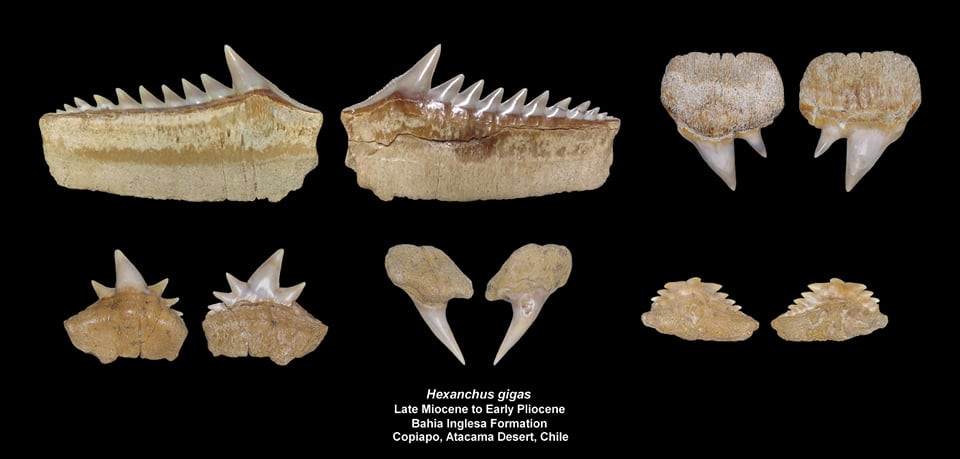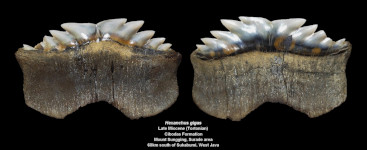Hexanchus gigas
(Sismonda, 1861)
Classification: Elasmobranchii Hexanchiformes Hexanchidae
Reference of the original description
Appendice alla descrizione dei pesci e dei crostacei fossili nel Piemonte. Memorie della Reale Accademia della Scienze di Torino, 19, 453–474
Appendice alla descrizione dei pesci e dei crostacei fossili nel Piemonte. Memorie della Reale Accademia della Scienze di Torino, 19, 453–474
Synonyms / new combinations and misspellings
Notidanus cf. gigas, Notidanus gigas
Notidanus cf. gigas, Notidanus gigas
Types
Hexanchus gigas
Hexanchus gigas
Description:
Citation: Hexanchus gigas (Sismonda, 1861): In: Database of fossil elasmobranch teeth www.shark-references.com, World Wide Web electronic publication, Version 01/2026
Please send your images of "Hexanchus gigas" to info@shark-references.com

Hexanchus gigas (Sismonda, 1861); Late Miocene to Early Pliocene, Bahia Inglesa Formation, Copiapo, Chile. Collection and © Adam Anderson

Hexanchus gigas (Sismonda, 1861); Late Miocene to Early Pliocene, Bahia Inglesa Formation, Copiapo, Chile. Collection and © Adam Anderson
Remarks
shark-references Species-ID=2853;
valid after Adnet & Martin (2007) p. 280 [22]; Kent (2018) p. 57 [26543]
shark-references Species-ID=2853;
valid after Adnet & Martin (2007) p. 280 [22]; Kent (2018) p. 57 [26543]
References
Paleozoic, Mesozoic and Cenozoic Chondrichthyes from the Japanese Islands. National Museum of Nature and Science Monographs, 56, 1–184

Faszination Haie – Die Welt der fossilen und der lebenden Haie. Der Steinkern, 58, 1–116

Nachweise der Selachier-Gattung Hexanchus RAFINESQUE, 1810, aus paläogenen Geschieben Norddeutschlands. Arbeitskreis Paläontologie Hannover, 47, 97–116

The modulating role of traits on the biogeographic dynamics of chondrichthyans from the Neogene to the present. Paleobiology, 44(2), 251–262
DOI: 10.1017/pab.2018.7
The Cartilaginous Fishes (Chimaeras, Sharks, and Rays) of Calvert Cliffs, Maryland, USA. In The Geology and vertebrate paleontology of Calvert Cliffs, Maryland / edited by Stephen J. Godfrey: 45-157

Mill-Langenboom (NL) – eine klassische Fundstelle für neogene marine Vertebraten. Der Steinkern, 23, 12–29

An overview of the Mexican fossil fish record. In G. Arratia, H.–P. Schultze & M.V.H. Wilson (Eds.), Mesozoic Fishes 5 – Global Diversity and Evolution (pp. 9–34). Verlag Dr. Friedrich Pfeil

Increase of body size in sixgill sharks with change in diet as a possible background of their evolution. Historical Biology, 19(4), 279–289
DOI: 10.1080/08912960701194461

Haaien en roggen van Mill. Afzettingen WTKG, 23(3), 56–57

Fossil Shark Teeth of the World. Lamna Books, 170 p

Asociaciones faunisticas de condrictios en el Cenozoico de la Peninsula de Baja California, Mexico. Profil, 18: 1–4

Haaien- en roggentanden uit Liessel (N.-B.) Fontys Hogescholen, Tilburg

Late Mesozoic and Cenozoic fish faunas of Japan. Island Arc, 3(4), 255–269
DOI: 10.1111/j.1440-1738.1994.tb00115.x

Fossil Sharks of the Chesapeake Bay Region. Egan Rees and Boyer, Inc. Columbia. 146 pp.

Selacios del Terciario Tardío de Sacaco, Departamento de Arequipa. Boletín de Lima, 69, 91–95

Late Cenozoic elasmobranchs from the Hokuriku district, Central Japan. Science Reports of Kanazawa University, 34(1): 1–57, 1 fig., pl. 1–8


Fossiles de Belgique. Dents de Requins et de Raies du Tertiaire de la Belgique. Institut royal des Sciences naturelles de Belgique, 184 pp.

Stand der Untersuchungen an der Chondrichthyes-Fauna des nordwestdeutschen Tertiärs. Beiträge zur regionalen Geologie der Erde, 18, 503–509


Haaie- en Roggentanden uit het Tertiair van Belgie. Institut royal des Sciences naturelles de Belgique, 1–171

Geology and paleontology of late Cenozoic marine deposits in the Sacaco area (Peru). Geologische Rundschau, 74(3), 547–563
DOI: 10.1007/BF01821211

Geology and paleontology of late Cenozoic marine deposits in the Sacaco area (Peru). Geologische Rundschau, 74(3), 547–563
DOI: 10.1007/BF01821211

Haaietanden en andere Tertiaire visresten uit Kallo (Belgie) [in Dutch]. GEA, 18(4), 125–160

Stratigrafische interpretatie van Jong-Cenozoische afzettingen bij Rumst (Belgie, provincie Antwerpen) en beschrijving van de in een Post-Mioceen basisgrind aangetroffen vissenfauna, II. Systematische beschrijvingen en conclusies. Mededelingen Van De Werkgroep Voor Tertiaire En Kwartaire Geologie, 13(4), 119–172
Lithostratigraphical and biostratigraphical subdivision of Tertiary deposits (Oligocene - Pliocene) in the Winterswijk - Almelo region (eastern part of the Netherlands). Scripta Geologica, 29, 1–167


Quelques restes de sélaciens récoltés dans les sables du Kattendijk à Kallo. I. Selachii - Euselachii. Bulletin de la Société Belge de Géologie, 83(1), 15–31
Die Selachier-Fauna (Pisces, Elasmobranchii) des Wiener Beckens und seiner Randgebiete im Badenien (Miozän). Annalen des Naturhistorischen Museums in Wien, 75, 311–341

Die Fischfauna der Eggenburger Schichtengruppe. In Steininger, F., Senes, J. & Mitarbeiter (1971a): M1 Eggenburgien. Die Eggenburger Schichtengruppe und ihr Stratotypus. – Chronostratigraphie und Neostratotypen, Miozän der zentralen Paratethys, 2, 719–759

Het Mioceen Van Delden. III: De Selachiërfauna int de miocene afzettingen in het Twente-kanaal bij Delden. Publicatiës van het Natuurhistorisch Genootschap in Limburg, 29, 25–36

Het Keienboek. 5th Edition. Thieme & Cie, Zutphen. 390 pp.

Contribuiciao para o conhecimento da fauna ictiológica do Miocénico Marinho de Portugal Continental. Revista da Faculdade de Ciências da Universidade de Lisboa, Serie C, 4, 39–119
Spodnomiocénna fauna pri Rapovciach [Die untermiozane Fauna bei Rapovce]. Geologica Carpathica, 3(3/4), 315–362

Das Tertiär der Niederlande mit besonderer Berücksichtigung der Selachier-Fauna. Leidsche Geologische Mededelingen, (9), 177–361

Das Tertiär der Niederlande mit besonderer Berücksichtigung der Selachier-Fauna. Leidsche Geologische Mededelingen, (9), 177–361

Les Poissons Fossiles d'Oran. Matériaux pour la Carte Géologique de l'Algérie, 6, 1–298
Les poissons tertiaires de Belgique. IV. Les poissons néogènes. Mémoires du Musée Royal d'Histoire Naturelle de Belgique, 32, 367–472
L'âge du gravier fossilifère d'Elsloo (Limbourg hollandais), d'après sa faune ichthyologique. La position du Boldérien dans le Néogène de la Belgique. Bulletin de la Société Belge de Géologie, de Paléontologie et d'Hydrologie, 30, 101–115
Contribuzione allo studio dei pesci terziarii del Piemonte e della Liguria. Memorie della Reale Accademia della Scienze di Torino, 45(2), 262–294

Catalogue of the fossil fishes in the British Museum. Part. I. British Museum (Natural History): 474 p., fig., 17 pl.
On the palaeontology of the selachian genus Notidanus CUVIER. Geological Magazine, decade 3, 3, 205–217, 253–259
Monografia dei reste del genere Notidanus rinvenuto nel Pliocene subappenino toscano. Atti della Società Toscana di Scienze Naturali, Mem., 3, 57–76
Dei resti di pesci fossili del Pliocene toscano. Atti della Società Toscana di Scienze Naturali, 1, 59–66
Paleozoic, Mesozoic and Cenozoic Chondrichthyes from the Japanese Islands. National Museum of Nature and Science Monographs, 56, 1–184

Faszination Haie – Die Welt der fossilen und der lebenden Haie. Der Steinkern, 58, 1–116

Nachweise der Selachier-Gattung Hexanchus RAFINESQUE, 1810, aus paläogenen Geschieben Norddeutschlands. Arbeitskreis Paläontologie Hannover, 47, 97–116

The modulating role of traits on the biogeographic dynamics of chondrichthyans from the Neogene to the present. Paleobiology, 44(2), 251–262
DOI: 10.1017/pab.2018.7
The Cartilaginous Fishes (Chimaeras, Sharks, and Rays) of Calvert Cliffs, Maryland, USA. In The Geology and vertebrate paleontology of Calvert Cliffs, Maryland / edited by Stephen J. Godfrey: 45-157

Mill-Langenboom (NL) – eine klassische Fundstelle für neogene marine Vertebraten. Der Steinkern, 23, 12–29

An overview of the Mexican fossil fish record. In G. Arratia, H.–P. Schultze & M.V.H. Wilson (Eds.), Mesozoic Fishes 5 – Global Diversity and Evolution (pp. 9–34). Verlag Dr. Friedrich Pfeil

Increase of body size in sixgill sharks with change in diet as a possible background of their evolution. Historical Biology, 19(4), 279–289
DOI: 10.1080/08912960701194461

Haaien en roggen van Mill. Afzettingen WTKG, 23(3), 56–57

Fossil Shark Teeth of the World. Lamna Books, 170 p

Asociaciones faunisticas de condrictios en el Cenozoico de la Peninsula de Baja California, Mexico. Profil, 18: 1–4

Haaien- en roggentanden uit Liessel (N.-B.) Fontys Hogescholen, Tilburg

Late Mesozoic and Cenozoic fish faunas of Japan. Island Arc, 3(4), 255–269
DOI: 10.1111/j.1440-1738.1994.tb00115.x

Fossil Sharks of the Chesapeake Bay Region. Egan Rees and Boyer, Inc. Columbia. 146 pp.

Selacios del Terciario Tardío de Sacaco, Departamento de Arequipa. Boletín de Lima, 69, 91–95

Late Cenozoic elasmobranchs from the Hokuriku district, Central Japan. Science Reports of Kanazawa University, 34(1): 1–57, 1 fig., pl. 1–8


Fossiles de Belgique. Dents de Requins et de Raies du Tertiaire de la Belgique. Institut royal des Sciences naturelles de Belgique, 184 pp.

Stand der Untersuchungen an der Chondrichthyes-Fauna des nordwestdeutschen Tertiärs. Beiträge zur regionalen Geologie der Erde, 18, 503–509


Haaie- en Roggentanden uit het Tertiair van Belgie. Institut royal des Sciences naturelles de Belgique, 1–171

Geology and paleontology of late Cenozoic marine deposits in the Sacaco area (Peru). Geologische Rundschau, 74(3), 547–563
DOI: 10.1007/BF01821211

Geology and paleontology of late Cenozoic marine deposits in the Sacaco area (Peru). Geologische Rundschau, 74(3), 547–563
DOI: 10.1007/BF01821211

Haaietanden en andere Tertiaire visresten uit Kallo (Belgie) [in Dutch]. GEA, 18(4), 125–160

Stratigrafische interpretatie van Jong-Cenozoische afzettingen bij Rumst (Belgie, provincie Antwerpen) en beschrijving van de in een Post-Mioceen basisgrind aangetroffen vissenfauna, II. Systematische beschrijvingen en conclusies. Mededelingen Van De Werkgroep Voor Tertiaire En Kwartaire Geologie, 13(4), 119–172
Lithostratigraphical and biostratigraphical subdivision of Tertiary deposits (Oligocene - Pliocene) in the Winterswijk - Almelo region (eastern part of the Netherlands). Scripta Geologica, 29, 1–167


Quelques restes de sélaciens récoltés dans les sables du Kattendijk à Kallo. I. Selachii - Euselachii. Bulletin de la Société Belge de Géologie, 83(1), 15–31
Die Selachier-Fauna (Pisces, Elasmobranchii) des Wiener Beckens und seiner Randgebiete im Badenien (Miozän). Annalen des Naturhistorischen Museums in Wien, 75, 311–341

Die Fischfauna der Eggenburger Schichtengruppe. In Steininger, F., Senes, J. & Mitarbeiter (1971a): M1 Eggenburgien. Die Eggenburger Schichtengruppe und ihr Stratotypus. – Chronostratigraphie und Neostratotypen, Miozän der zentralen Paratethys, 2, 719–759

Het Mioceen Van Delden. III: De Selachiërfauna int de miocene afzettingen in het Twente-kanaal bij Delden. Publicatiës van het Natuurhistorisch Genootschap in Limburg, 29, 25–36

Het Keienboek. 5th Edition. Thieme & Cie, Zutphen. 390 pp.

Contribuiciao para o conhecimento da fauna ictiológica do Miocénico Marinho de Portugal Continental. Revista da Faculdade de Ciências da Universidade de Lisboa, Serie C, 4, 39–119
Spodnomiocénna fauna pri Rapovciach [Die untermiozane Fauna bei Rapovce]. Geologica Carpathica, 3(3/4), 315–362

Das Tertiär der Niederlande mit besonderer Berücksichtigung der Selachier-Fauna. Leidsche Geologische Mededelingen, (9), 177–361

Das Tertiär der Niederlande mit besonderer Berücksichtigung der Selachier-Fauna. Leidsche Geologische Mededelingen, (9), 177–361

Les Poissons Fossiles d'Oran. Matériaux pour la Carte Géologique de l'Algérie, 6, 1–298
Les poissons tertiaires de Belgique. IV. Les poissons néogènes. Mémoires du Musée Royal d'Histoire Naturelle de Belgique, 32, 367–472
L'âge du gravier fossilifère d'Elsloo (Limbourg hollandais), d'après sa faune ichthyologique. La position du Boldérien dans le Néogène de la Belgique. Bulletin de la Société Belge de Géologie, de Paléontologie et d'Hydrologie, 30, 101–115
Contribuzione allo studio dei pesci terziarii del Piemonte e della Liguria. Memorie della Reale Accademia della Scienze di Torino, 45(2), 262–294

Catalogue of the fossil fishes in the British Museum. Part. I. British Museum (Natural History): 474 p., fig., 17 pl.
On the palaeontology of the selachian genus Notidanus CUVIER. Geological Magazine, decade 3, 3, 205–217, 253–259
Monografia dei reste del genere Notidanus rinvenuto nel Pliocene subappenino toscano. Atti della Società Toscana di Scienze Naturali, Mem., 3, 57–76
Dei resti di pesci fossili del Pliocene toscano. Atti della Società Toscana di Scienze Naturali, 1, 59–66


















